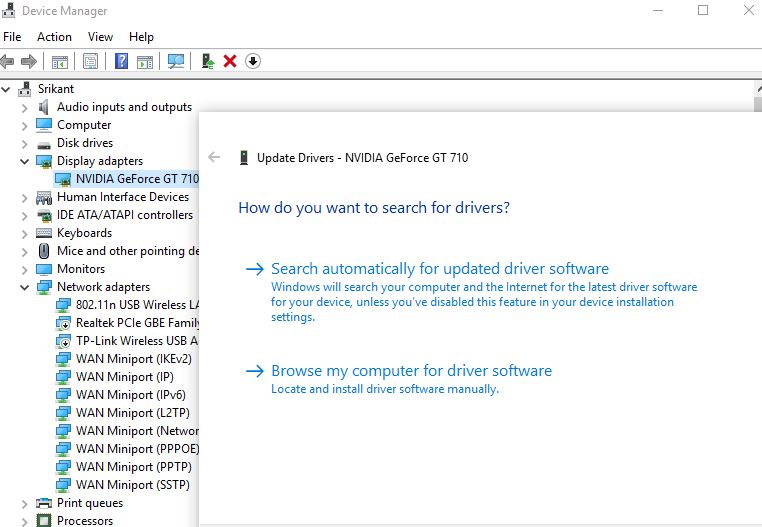Solved: Black screen while playing Games on Windows 11 or 10
If your screen goes black each and every time you start playing a new game, Here few workaround help fix black screen problem when playing games windows 10

Have you noticed, the Monitor screen goes black for a few seconds while playing games on Windows? You are not alone a few windows 10 users report, Since installing the latest windows update Getting random black screen while playing games, or the screen goes black but they are able to hear the game playing in the background. And the most common reason for this problem could be the display (graphics) driver, Either it’s outdated or not compatible with the current Windows 10 version 21H2. Again Hardware Compatibility Issues, your PC (Windows version) doesn’t support this game, or Some additional software is missing like the dot net framework that prevents the game from running smoothly.
Whatever the reason, If your screen goes black each and every time you start playing a new game, you can try the following troubleshooting methods to fix this issue and resume playing your games.
Black screen when playing games
Okay, so if you are a hardcore gamer and like to play bulky games on your Windows 10 computer, then you are likely going to face a black screen a lot. So, if you don’t want to stop your gaming session because of these errors, then you should remember the following solutions.
The first thing we recommend check your game’s minimum requirements and see if your PC’s hardware is ok to play the game.
Install the latest Windows Updates
Most of the Windows 10 errors can be fixed by updating your software. That’s because Windows 10 comes with monthly security updates where Microsoft fixes mostly all the latest bugs. So, simply by updating your Windows 10, you can fix the black screen error which mostly occurs while playing games. You just need to make sure that your system is running over the latest Windows 10 and for this, you have to follow these steps.
- Press Windows key + I to open the Settings app,
- Click on Update & security then windows update,
- Now click the Check for updates button to allow download window update from the Microsoft server,
- Once done, restart your PC to apply the changes,
- Try to play your games now and verify if the black screen problem persists or not.

Update Graphics Drivers
The black screen problem can occur due to the outdated graphic driver or damaged graphic driver files as well. If this is the problem with your computer, then you can easily fix it by updating your drivers using Device Manager.
Update drivers using Device Manager
- First of all, right-click on the Windows Start icon on your PC.
- A list of options will appear in front of you and from it select the Device Manager option.
- From the Device Manager, expand Display adapters.
- Right-click on the graphics (Display) driver and click update driver.
- Click on Search automatically for updated driver software to allow check and download the latest driver software from the Microsoft server,
- If updates are available, then install them and restart your computer to check the status of the black screen error.

Update driver automatically using third-party tools
If you don’t want to risk your graphic driver by manually installing it or you don’t know to install them, then you can use numerous third-party tools that can automatically update your graphic driver. After installing the tools, you won’t have to worry about the outdated graphic driver as the tool will instantly update your drivers when a new update is available. This is the easiest solution for inexperienced users.
Reinstall Drivers
In some cases, the automatic update of your drivers might get corrupted files installed on the PC. So, to avoid such situations, you should manually update all of your drivers so that the black screen error can be fixed. For the manual process, you have to follow these steps.
- Go to Device Manager once again as we have discussed earlier.
- Open your graphic drivers or any other driver and right-click on every entry.
- From the submenu, select uninstall.
- Now, go to Control Panel by right-clicking on the Start Menu.
- In Control Panel, switch category and press over uninstall.
- Find the entries related to your driver and uninstall them.
- Once everything is uninstalled, then restart your Windows 10 computer system.
- Lastly, you have to visit the website of the official manufacturer and download the latest version of your drivers which is the most compatible with your Windows 10 device and prompt the installation process.
Go Through Advanced Power Options
- You have to open the Control Panel on your computer as the method we are discussed already.
- Under the search section, enter the power option and look for the entries with the same name.
- From your current Power Plan, click on Change plan settings.
- Next, click on Change advanced power settings.
- From the up next window, you have to extend the PCI Express.
- Lastly, ensure that State Power Management is off for your computer.
Okay, so people, when Windows 10 turns black screen while playing games for you, then no need to worry. Just update your Windows 10 graphic driver, other drivers or check your advance options and everything will get back to normal. Now, you can play games without any interruption on your Windows 10.
